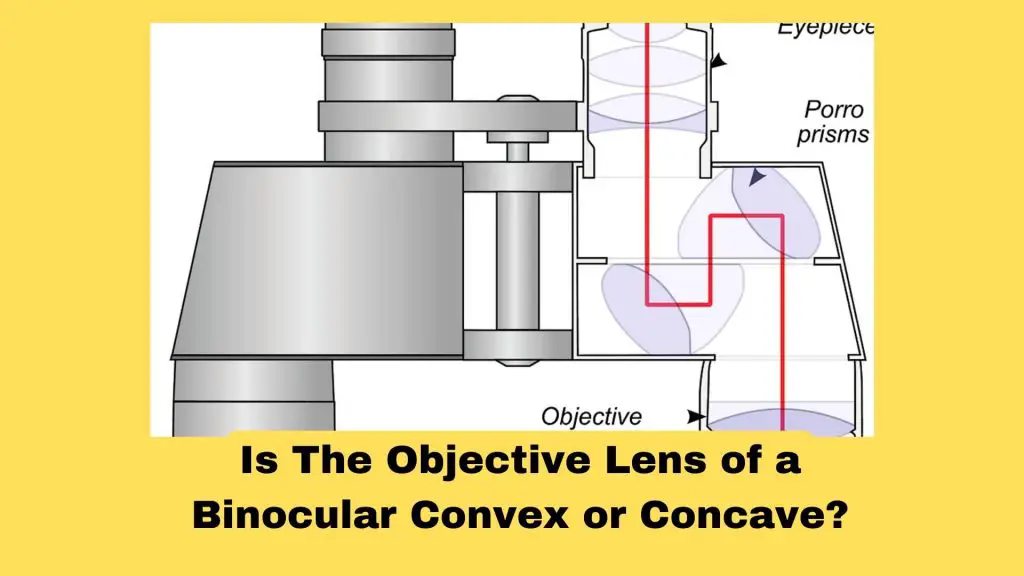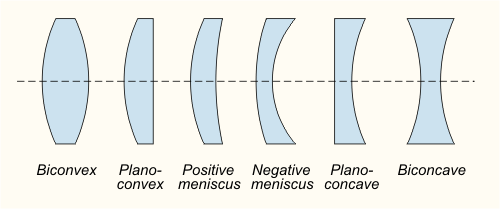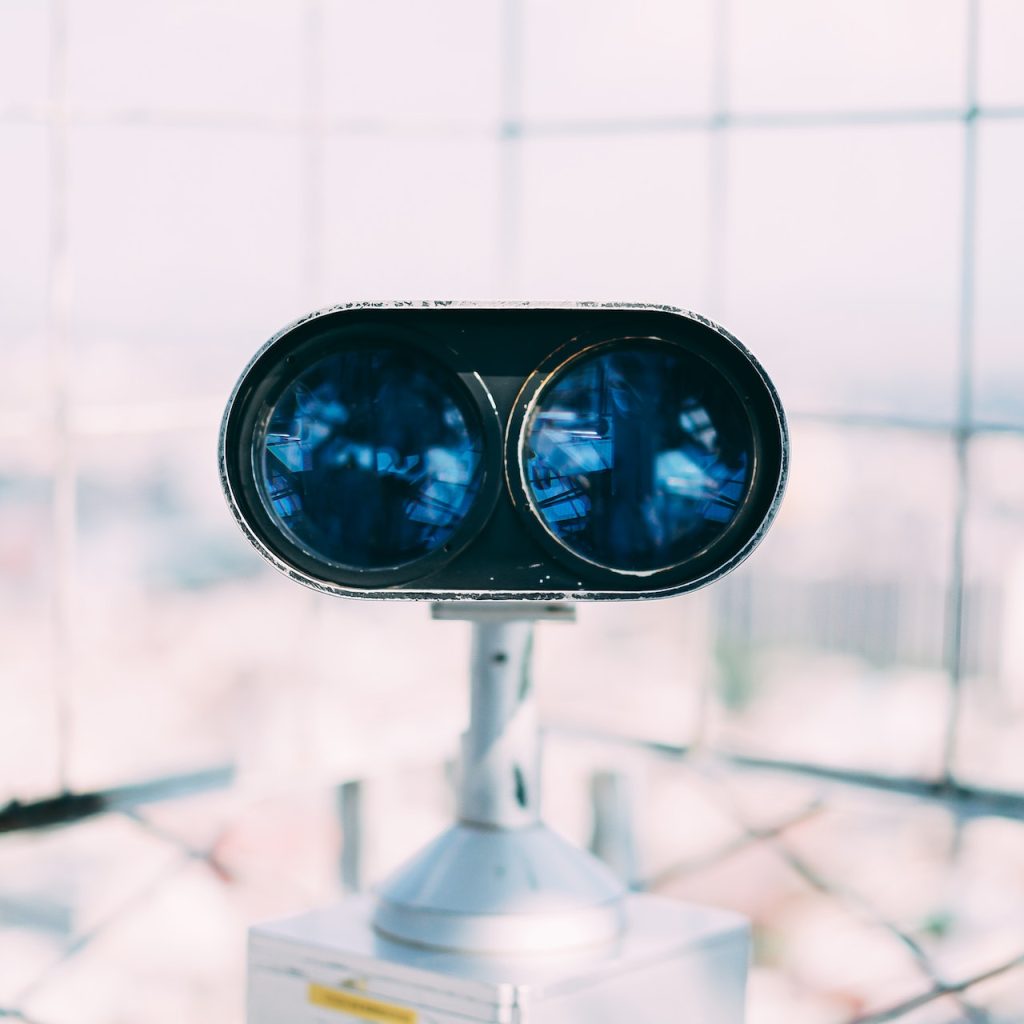Is The Objective Lens of a Binocular Convex or Concave?
Hello and welcome to our discussion about an important question in the world of binoculars: Is the objective lens convex or concave?
You know, binoculars have always been such a fascinating tool, allowing us to see distant objects up close and experience the beauty of nature like never before.
And at the heart of these optical marvels lies the objective lens, located right at the front of the binoculars, capturing light and forming the images we see through the eyepieces.
But, have you ever wondered about the shape of this crucial lens?
In this article, we’ll uncover the truth about the objective lens in binoculars. We’ll delve into the realm of optics and dive deep into the concepts of convex and concave lenses.
Also, we’ll uncover the design philosophy behind the objective lens and its role in shaping the binocular experience.

Quick Answer: While a single convex lens is commonly used as an objective lens in binoculars, multiple lenses may be employed, including plano-convex or positive meniscus lenses. Inexpensive binoculars often feature a cemented achromat, consisting of a double-convex lens and a meniscus lens, which minimizes chromatic aberration. More advanced models may incorporate a complex objective lens design, such as a cemented doublet with an additional independent lens.
First, let’s understand convex and concave lenses

Image Credit: Wikipedia
Understanding Convex Lenses
What is a Convex Lens and Its Characteristics
A convex lens is a transparent optical component that is thicker at the center and thinner at the edges, causing it to bulge outward.
It is characterized by a curved surface that is uniformly curved throughout its structure.
Convex lenses are typically made of materials such as glass or plastic and are widely used in various optical devices due to their unique properties.
Convex Lens and Its action on Light
The key properties of convex lenses include their ability to converge light rays, create magnified and erect images, and focus parallel light rays to a point known as the focal point.
These properties make convex lenses valuable in a variety of applications, including binoculars, cameras, telescopes, and eyeglasses.
When light passes through a convex lens, it undergoes refraction, which is the bending of light as it transitions from one medium to another.
Convex lenses cause light rays to converge towards a focal point on the opposite side of the lens from the light source.
This convergence occurs because the curved shape of the lens causes the outer rays to bend more than the central rays, resulting in them focusing at a point.
The extent of refraction and the position of the focal point depend on the curvature and thickness of the convex lens.
Thicker lenses with more pronounced curves have shorter focal lengths, meaning the convergence point is closer to the lens. Conversely, thinner lenses with gentler curves have longer focal lengths.
Convex Lenses in Optical Devices
Convex lenses find widespread application in various optical devices due to their ability to manipulate light. Some common uses of convex lenses include:
Magnifying Glasses:
Convex lenses are utilized in magnifying glasses to enlarge small objects or text by creating a magnified and clearer image.
By placing the object closer to the lens than its focal length, an enlarged virtual image is produced, making it easier to view details.
Cameras and Camcorders:
Convex lenses are integral components of camera lenses, allowing photographers and videographers to focus and capture images with clarity.
These lenses help adjust the focal length, control depth of field, and produce sharp, well-defined images.
Projectors:
In projectors, convex lenses play a crucial role in focusing and enlarging images onto a screen.
They gather light from a source and project it onto a larger surface, enabling the audience to view the images or videos clearly.
Telescopes and Binoculars:
Convex lenses serve as the objective lenses in telescopes and binoculars, responsible for collecting light from distant objects.
These lenses gather the incoming light, focus it, and direct it towards the eyepiece, allowing users to observe faraway celestial bodies or objects with enhanced detail.
Convex Lenses in Real-world Applications
Convex lenses have become an integral part of our daily lives, often found in the following applications:
Eyeglasses and Contact Lenses:
Convex lenses are used to correct various vision problems such as farsightedness (hyperopia) or presbyopia.
By bending light entering the eye, these lenses compensate for refractive errors, helping individuals achieve clearer vision.
Magnifying Mirrors:
Many cosmetic mirrors or shaving mirrors incorporate convex lenses to magnify the reflection of the user’s face.
This allows for closer examination and precise grooming.
Car Rearview Mirrors:
The rearview mirrors in automobiles often feature convex lenses.
This design choice widens the field of view, allowing drivers to have a broader perspective of the traffic behind them and reducing blind spots.

Understanding Concave Lenses
What is a Concave Lens
A concave lens, also known as a diverging lens, is a transparent optical component that is thinner at the center and thicker at the edges, causing it to curve inward.
Unlike convex lenses, concave lenses have surfaces that are curved inwards and bulge outwards. These lenses are typically made of materials such as glass or plastic and possess unique optical properties.
Properties of Concave Lens
The key properties of concave lenses include their ability to diverge light rays, create reduced and virtual images, and spread out parallel light rays.
These properties make concave lenses valuable in various optical applications, particularly where the need arises to correct vision problems or create specific optical effects.
Concave Lens Action On Light
When light passes through a concave lens, it undergoes refraction, causing the light rays to spread out or diverge.
This occurs because the outer rays bend away from the central axis of the lens more than the central rays, resulting in the spreading out of light rays instead of focusing them at a point.
The extent of refraction and the behavior of concave lenses depend on the curvature and thickness of the lens.
Thinner lenses with more pronounced curves have shorter focal lengths, causing the divergence to be more significant.
Conversely, thicker lenses with gentler curves have longer focal lengths and result in less pronounced divergence.
Concave Lenses in Optical Devices
Concave lenses find practical applications in a variety of optical devices due to their ability to diverge light. Some common uses of concave lenses include:
Corrective Eyeglasses:
Concave lenses are used to correct nearsightedness (myopia) by diverging the incoming light rays before they reach the eye’s lens.
This divergence allows the image to be properly focused on the retina, improving vision for individuals with myopia.
Spotlights and Flashlights:
Concave lenses are used in spotlights and flashlights to spread out the light emitted from a source.
By causing light rays to diverge, concave lenses create a wider beam angle, enabling better coverage and illumination of a larger area.
Peepholes:
Concave lenses are commonly used in peepholes on doors, providing a wider angle of view to see who is outside

Objective Lens in Binoculars
Where is Objective Lens in a Binocular?
The objective lens is a vital component of binoculars, located at the front of the device. It is the larger lens or set of lenses responsible for gathering light from the observed scene or object.
What is the Function of the objective lens in a Binocular?
The primary function of the objective lens is to collect as much light as possible, allowing for brighter and clearer images.
It determines the light-gathering capabilities of the binoculars, influencing their performance in various lighting conditions and enabling better visibility of distant objects.
Also Check: How Do Binoculars Work
Factors to consider when designing the objective lens in A Binocular
When designing the objective lens for binoculars, several factors need to be considered to ensure optimal performance and image quality. These factors include:
Gathering light:
The objective lens should have a sufficient diameter to collect ample light from the observed scene.
A larger objective lens diameter allows more light to enter the binoculars, resulting in brighter images, especially in low-light conditions.
Minimizing aberrations:
The objective lens should be designed to minimize optical aberrations, such as chromatic aberration and spherical aberration.
Chromatic aberration causes color fringing and reduces image sharpness, while spherical aberration affects focus and overall image quality.
Designing the objective lens with appropriate curvature and utilizing special lens coatings can help minimize these aberrations.
Achieving optimal magnification:
The objective lens determines the magnification power of the binoculars.
The choice of objective lens focal length, combined with the eyepiece design, determines the overall magnification.
Designers must strike a balance between achieving higher magnification for detailed observations and maintaining a wide field of view for a broader perspective.
Design Choices For Objective Lenses
Binoculars employ various design choices for the objective lens based on the intended use and desired performance characteristics.
Some common design choices include:
Single Objective Lens:
Many binoculars feature a single objective lens for each side.
This design simplifies construction, reduces weight, and allows for compact binoculars suitable for casual use or portability.
Single-objective lens designs are commonly found in entry-level or compact binocular models.
Doublet Objective Lens:
A doublet objective lens consists of two lens elements bonded together, typically composed of different types of glass.
This design helps address chromatic aberration by combining different refractive properties.
The doublet objective lens is commonly used in mid-range binoculars, offering improved image quality compared to single-lens designs.
Triplet Objective Lens:
The triplet objective lens employs three lens elements, often made of different glass types.
This design is effective in minimizing aberrations, resulting in superior image quality and sharpness.
Triplet objective lenses are commonly found in high-end or professional-grade binoculars, especially those designed for astronomy or critical observations.
Apochromatic Objective Lens:
Apochromatic (APO) objective lenses utilize extra-low dispersion (ED) glass or other specialized materials to further reduce chromatic aberration.
These lenses provide exceptional color fidelity and image clarity, making them highly desirable for demanding applications such as birdwatching, wildlife observation, or astrophotography.
It’s worth noting that the specific design choices for objective lenses may vary among different binocular manufacturers and models.
Each design aims to optimize light gathering, reduce aberrations, and deliver the desired performance characteristics based on the target audience and application requirements.
Arguments for Concave & Convex Lens use In Binoculars
When evaluating the arguments for both convex and concave objective lenses, it is important to consider the context and specific requirements of the binocular design.
Convex lenses have proven to be highly effective in gathering light, providing image magnification, and aligning with established optical designs.
Their reliability and widespread use make them the conventional choice in binocular manufacturing.
On the other hand, arguments for concave objective lenses are often more niche, limited to specialized applications or unique optical considerations.
While they may offer certain benefits in specific scenarios, the use of concave lenses in binoculars is less common and may require careful design considerations to optimize their performance.
So, What is The Actual Lens Used In the Objective Lens of a Binocular
In most cases, the objective lens consists of multiple lenses rather than a single lens.
If it were a single lens, it would typically be convex, possibly double-convex. However, it is possible to use plano-convex or positive meniscus lenses for the objective lens if desired.
In practice, even inexpensive binoculars typically have a more complex objective lens.
At the very least, it will consist of two lenses that form a cemented achromat, which helps minimize chromatic aberration.
A cemented achromat usually consists of a double-convex lens and a meniscus lens, with the concave surface of the meniscus lens matching the curvature of one face of the convex lens, allowing them to fit together without any gap.
These two elements are then glued together to form the objective lens.
More Interesting Read:
What Is The Binoculars Lens Coating For?
Exploring the Purpose of Ruby Red Lenses in Binoculars
Are HD Binoculars Worth The Money?
Conclusion
While the objective lens of a binocular is commonly designed as a convex lens, the use of multiple lenses is prevalent in modern binoculars, ensuring enhanced image quality and minimizing aberrations.
The versatility of the objective lens design allows manufacturers to tailor binoculars to specific needs and applications.
The cemented achromat, comprising a double-convex lens and a meniscus lens, is a common configuration utilized in affordable binoculars, effectively reducing chromatic aberration.
For more advanced and high-end binoculars such as the Leica Noctivid 8×42 or 10×42, complex objectives may incorporate additional lenses, offering superior optical precision and clarity.
More Read: Can You Wear Contact Lenses While Using Binoculars
